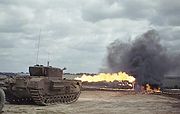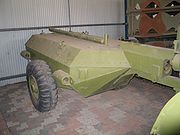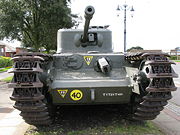
Churchill Crocodile
Encyclopedia



Flame tank
A flame tank is a type of tank equipped with a flamethrower, most commonly used to supplement combined arms attacks against fortifications, confined spaces, or other obstacles...
of late Second World War. It was a variant of the Tank, Infantry, Mk VI (A22) Churchill Mark VII
Churchill tank
The Tank, Infantry, Mk IV was a heavy British infantry tank used in the Second World War, best known for its heavy armour, large longitudinal chassis with all-around tracks with multiple bogies, and its use as the basis of many specialist vehicles. It was one of the heaviest Allied tanks of the war...
, although the Churchill Mark IV was initially chosen to be the base vehicle.
The Crocodile was introduced as one of the specialised armoured vehicles developed under Major-General Percy Hobart
Percy Hobart
Major-General Sir Percy Cleghorn Stanley Hobart KBE CB DSO MC , also known as "Hobo", was a British military engineer, noted for his command of the 79th Armoured Division during World War II...
, informally known as "Hobart's Funnies
Hobart's Funnies
Hobart's Funnies were a number of unusually modified tanks operated during World War II by the United Kingdom's 79th Armoured Division or by specialists from the Royal Engineers. They were designed in light of problems that more standard tanks experienced during the Dieppe Raid, so that the new...
". It was produced from October 1943, in time for the Normandy invasion.
Design and development
From early in the war, there had been experiments with mounting flamethrowers on British vehicles; leading to vehicles such as the CockatriceLagonda flamethrower
The Lagonda company produced a number of flamethrowers during the Second World War.Initial developments were for defence against expected German attacks. It was believed that it would act as a deterrent to Luftwaffe dive-bombers targeting the lightly defended Merchant Navy ships and coastal bases...
, Basilisk and the Wasp (the latter being a flamethrower on a Universal Carrier
Universal Carrier
The Universal Carrier, also known as the Bren Gun Carrier is a common name describing a family of light armoured tracked vehicles built by Vickers-Armstrong. Produced between 1934 and 1960, the vehicle was used widely by British Commonwealth forces during the Second World War...
). The Churchill Oke, a flamethrower carrying Churchill Mark II developed by a Royal Tank Regiment
Royal Tank Regiment
The Royal Tank Regiment is an armoured regiment of the British Army. It was formerly known as the Tank Corps and the Royal Tank Corps. It is part of the Royal Armoured Corps and is made up of two operational regiments, the 1st Royal Tank Regiment and the 2nd Royal Tank Regiment...
officer, was tested operationally on the Dieppe Raid
Dieppe Raid
The Dieppe Raid, also known as the Battle of Dieppe, Operation Rutter or later on Operation Jubilee, during the Second World War, was an Allied attack on the German-occupied port of Dieppe on the northern coast of France on 19 August 1942. The assault began at 5:00 AM and by 10:50 AM the Allied...
. Parallel development work was carried out by the Petroleum Warfare Department, AEC and the Ministry of Supply
Ministry of Supply
The Ministry of Supply was a department of the UK Government formed in 1939 to co-ordinate the supply of equipment to all three British armed forces, headed by the Minister of Supply. There was, however, a separate ministry responsible for aircraft production and the Admiralty retained...
(MoS) on Valentine tanks. The Department of Tank Design preferred the Churchill, which was the Infantry tank
Infantry tank
The infantry tank was a concept developed by the British and French in the years leading up to World War II. Infantry tanks were tanks designed to support the infantry in the attack. To achieve this they were generally heavily armoured compared to the cruiser tanks, to allow them to operate in...
successor to the Valentine, as a basis for further work.
General Percy Hobart
Percy Hobart
Major-General Sir Percy Cleghorn Stanley Hobart KBE CB DSO MC , also known as "Hobo", was a British military engineer, noted for his command of the 79th Armoured Division during World War II...
saw the Crocodile demonstrated in 1943 and pressured the MoS to produce a development plan and the Chief of the General Staff
Chief of the General Staff (United Kingdom)
Chief of the General Staff has been the title of the professional head of the British Army since 1964. The CGS is a member of both the Chiefs of Staff Committee and the Army Board...
added the flamethrowers to the 79th Division plan.
Final design
The flamethrower equipment was produced as a kit that REME workshops could fit in the field, converting any available Churchill Mk VII. The conversion kit consisted of the trailer, an armoured pipe fitted along the underside of the tank, and the projector, which replaced the hull mounted Besa machine gunBesa machine gun
The Besa Machine Gun was a British version of the Czechoslovak ZB-53 air-cooled, belt-fed machine-gun, which in the Czechoslovak army was marked as the TK vz. 37...
. The Crocodile was therefore still able to function as a gun tank with its turret mounted Ordnance QF 75 mm
Ordnance QF 75 mm
The Ordnance QF 75 mm, abbreviated to OQF 75 mm, was a British tank-gun of the Second World War. It was used instead of the Ordnance QF 6 pounder , an anti-tank gun, to give better performance against infantry targets in a similar fashion to the 75 mm gun fitted to the American...
gun.
Of the 800 kits produced, 250 were held in reserve for possible operations against the Japanese. The remainder was sufficient for producing three regiments of tanks as well as training and replacements for battlefield casualties.
400 gallons (1,818.4 l) of fuel and the compressed nitrogen propellant, enough for eighty one-second bursts, were stored in a 6½ ton detachable armoured trailer towed by the Crocodile. The trailer, connected to the tank by a three way armoured coupling, could be jettisoned from within the tank if necessary.
Flame projector
The thrower had a range of up to 120 yards (some sources quote 150 yards). The pressure required had to be primed on the trailer by the crew as close to use as feasible, because pressure could not be maintained for very long. The fuel was used at 4 gallons per second; refuelling took at least 90 minutes and pressurization around 15 minutes. The fuel burned on water and could be used to set fire to woods and houses. The flamethrower could project a "wet" burst of unlit fuel which would splash around corners in trenches or strongpoints and then ignite this with a second burst.Service
Used by units of the 79th Armoured Division in concert with the Churchill AVRE, and other Funnies, the Crocodile was an effective assault weapon whose threat could induce enemy troops to retreat or surrender. The Crocodile was a specialised weapon, best used against suitable targets and it was limited by the short range of its flamethrower. On the other hand, it was used so successfully against bunkers that many bunkers surrendered after the first ranging shots.Aspects of the mechanism were considered by the British to be so secret that disabled units, if they could not be recovered, were rapidly destroyed by any means, even air strike, if necessary.
British Crocodiles supported the U.S. Army in the Normandy bocage
Bocage
Bocage is a Norman word which has entered both the French and English languages. It may refer to a small forest, a decorative element of leaves, a terrain of mixed woodland and pasture, or a type of rubble-work, comparable with the English use of 'rustic' in relation to garden...
and, later, during Operation Clipper
Operation Clipper
During the Second World War, Operation Clipper was an Allied offensive by British XXX Corps to reduce the Geilenkirchen salient in mid-November 1944...
, the Anglo-American assault on Geilenkirchen
Geilenkirchen
Geilenkirchen is a town in the district Heinsberg, in North Rhine-Westphalia, Germany. It is situated near the border with the Netherlands, on the river Wurm, approx. 15 km north-east of Heerlen and 20 km north of Aachen....
. C Squadron also supported the 53rd Welch Division assault on s`Hertogenbosch in October 1944.
The units that used the Crocodile were
in Europe, the 31st Armoured Brigade:
- 1st Fife and Forfar Yeomanry
- 141st Regiment Royal Armoured Corps (The Buffs, Royal East Kent Regiment)13th Troop C squadron 141 RAC saw action on the first day of the Normandy invasion.
- 7th Royal Tank Regiment7th Royal Tank RegimentThe 7th Royal Tank Regiment was an armoured regiment of the British Army until 1959.-History:The 7th Royal Tank Regiment was part of the Royal Tank Regiment, itself part of the Royal Armoured Corps...
In Italy the 25th Armoured Assault Brigade
25th Armoured Engineer Brigade Royal Engineers (United Kingdom)
The formation was founded on 5 January 1945, in Italy, as 'B' Assault Brigade RAC/RE. The Brigade Headquarters was formed from redesignting the 25th Army Tank Brigade's headquarters to the 25th Armoured Assault Brigade Royal Engineers. Three months later, on 6 April, the formation was redesignated...
operated Crocodiles.
Surviving vehicles
Mark VII Crocodiles are owned by the Muckleburgh CollectionMuckleburgh Collection
The Muckleburgh Collection is a military museum sited on a former military camp at Weybourne, on the North Norfolk coast, England. It was opened to the public in 1988 and is the largest privately-owned military museum in the United Kingdom.-History:...
in Norfolk, the Cobbaton Combat Collection in Devon, the D-Day museum
D-Day museum
The D-Day Museum is located in Southsea, near Portsmouth in Hampshire, England. Opened in 1984 by HM Queen Elizabeth The Queen Mother, it tells the story of Operation Overlord during the Normandy D-Day landings...
in Portsmouth, the Wheatcroft Collection, the Kubinka Tank Museum
Kubinka Tank Museum
The Kubinka Tank Museum is a large museum of armoured fighting vehicles in Kubinka, just outside Moscow. It has many famous tanks from World War I, World War II and the Cold War. The museum also houses many unique vehicles, such as the Panzer VIII Maus, Troyanov super-heavy tank and a Karl-Gerät...
in Russia and the Museum of the Regiments
The Military Museums
The Military Museums is a reorganization of the former Museum of the Regiments in Calgary, Alberta, announced by Sophie, Countess of Wessex, on June 3, 2006...
, Calgary, Alberta. A Mark VIII is at the Royal Australian Armoured Corps Museum. Two (one in running order) are privately owned in the UK. One example, without trailer, on display at the Bayeux Museum of the Battle of Normandy and a trailer is held at the Bovington Tank Museum
Bovington Tank Museum
The Tank Museum is a collection of armoured fighting vehicles in the United Kingdom that traces the history of the tank. With almost 300 vehicles on exhibition from 26 countries it is the second-largest collection of tanks and armoured fighting vehicles in the world.The Musée des Blindés in France...
.

